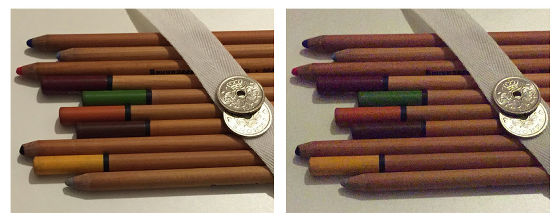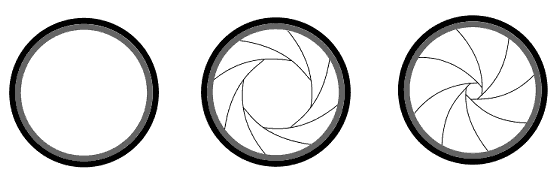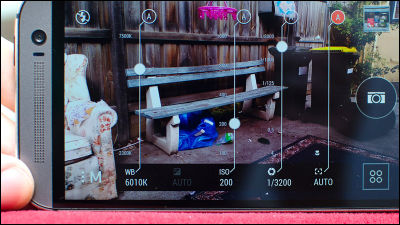Explain from the basic principle of the camera how the camera image quality of the smartphone is determined

As there are people who use smartphones for the first time, cameras of smartphones have become commonplace. However, if you have never used a conventional camera and do not have any knowledge of the camera at all, you do not know how to change the various parameters and how it will affect the photos, mass-produce photographs that are not irrelevant It can be said that it is a waste. Even those who have little knowledge of such cameras, so that the minimum necessary knowledge about cameras will be attached, programmers / photographersDaniel EgertExplained politely.
How Your Camera Works · objc.io
https://www.objc.io/issues/21-camera-and-photos/how-your-camera-works/
The basic principle of the camera was invented about 200 years ago. The principle is basically the same as photons emitted by the sun's light bouncing off objects and striking the retina in the human eye so that the human being feels vision, and the camera draws the picture by hitting the light on the film doing.
Currently, the most popular cameras are smartphones and it is not exaggeration to say. Cameras mounted on smartphones do not use film as in the past but digital sensors pick up light and project them as photographs
According to Mr. Egato, it is important to know the basic concepts necessary for camera shooting before considering the mechanism of capturing light with sensors.
◆ Control of light intensity (exposure)
Since the camera is a machine that gathers light, adjusting the amount of light is an essential task for photography. It is the "exposure value" that shows how much light is gathered, which is determined by the aperture value (F value) and the shutter speed, which will be described later.
In general, the fact that the exposure value is too small is called "underexposure", and in the state of underexposure a dark picture (left) is made. Pictures with insufficient exposure can be adjusted with software such as Pixelmator (right). However, if the original image is too underexposed, it often happens that the dark part of the picture remains black and the correction does not work.

Conversely, if the exposure value is too large, it is called "over exposure". In the photo with over exposure (left) the gradation of the bright part is lost and it becomes a white state "White jumpIt is called. Photos with overexposure can also be adjusted with software, but if the degree is intense the whole will be white or grayish photograph (right).

It is very important to think about how much light should be gathered when taking pictures and it is very important to shoot so as to avoid exposure and overexposure so that there is no posterior image correction Egato says.
◆ Stops
In the world of photography, it is customary to call the amount of light with the unit of "Stop". It is counted as "1 step raising" that the amount of light doubles, "1 step lowering" that the amount of light becomes 1/2 times. And it is important to understand that there are three factors affecting this "step": "shutter speed", "ISO speed" and "aperture".
·shutter speed
The time when the shutter of the camera is open is "shutter speed"The length of this time is proportional to the amount of light taken in. That is, if you adjust the stage with just the shutter speed, it will go up one step if it is twice the length. Also, if the shutter speed is slow such as 1/5 (0.2 sec), it is necessary to suppress the camera shake by, for example, fixing the photograph to a tripod, the speed of the shutter speed will cause camera shake It is greatly related.
· ISO sensitivity
Showing how weak light can be recorded on the photographic film of analog cameras is "ISO sensitivity"This value is also used as a degree of light that can be sensed by the sensor even with digital cameras. For example, iPhone 6 can be adjusted from ISO 32 to ISO 1600.
As the ISO sensitivity increases, the shooting with a scene with less light (darker) becomes possible, but as the number increases the noise appears in the camera.
When comparing ISO 32 (left) and ISO 1600 (right), it can be confirmed that the noise is slightly on the entire photo in ISO 1600.

· Aperture (F value)
A mechanism for adjusting the size of the opening (hole) to adjust the amount of light passing through the lens is called "ApertureThe amount of light entering is expressed by the quantity called F value. The smaller the F value, the more light can be captured, so bright images can be taken. Unlike general lens type cameras, smartphone cameras often have a fixed F value, for example the F value of the iPhone 6 lens is fixed at 2.2.

◆ Combination of three elements
Exposure values are determined by combining the three elements of shutter speed, ISO sensitivity, and aperture (F value). As described above, in the smartphone camera, as described above, the exposure is adjusted by changing the shutter speed and the ISO sensitivity other than the aperture I can do it.
The reason why shooting in night or dark scenes is worse than shooting in daylight or bright scenes is because the amount of light that can be captured is small. That is, it is caused by chronic exposure shortage. In a dark scene, smartphone cameras first try to earn exposure by maximizing ISO sensitivity, but in most cases it is not enough and the shutter speed is slowing down. As a result, it becomes a bad photograph with noises full and camera shake occurring.
As there is a limit to the adjustment with shutter speed and ISO sensitivity, the fact that you can shoot good pictures even in dark places means that you have a lens with a small F value from the beginning and it is a smartphone with camera shake correction function .
◆ Role of image sensor
The image sensor of the smartphone hits the retina of the human eye. The image sensor can be considered as a part that converts light into an electrical signal. The image sensor consists of an enormous number of pixel sensors gathered.
The number of so-called "X X Million Pixels" indicates the number of pixel sensors, and the higher the number of pixels, the more high-resolution pictures can be taken. However, the beauty of the resulting photograph is not determined by the number of pixels alone.
Each pixel sensor is compared to a "bucket" that accumulates charges. It is known that as the size of the pixel sensor increases, more charge is stored, resulting in better image quality with less noise. However, since the image sensor of the smartphone camera needs to be housed in a small enclosure, it is limited in size. Therefore, with too many pixels too large "small buckets" that can not store so many charges gather densely, and the picture quality may deteriorate sometimes. Therefore, it is necessary to be careful that "8 million pixel smartphone cameras have better image quality than 13 million pixel smartphone cameras" can occur.

Related Posts:





